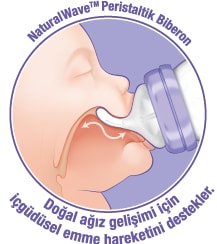Breastfeeding is a skill learned by both you and your baby and can take some time. Although breastfeeding is generally a very pleasant process, some mothers may experience nipple cracks when starting to breastfeed.
Nipple cracks are caused by the baby not grasping the nipple correctly. In order for the baby to suck effectively, it needs to latch on to the breast correctly. Research shows that there are 3 steps that babies follow in sucking on the mother’s breast.
1- Grasping
The baby opens its lips outwards and grasps most of the areola (brown area) of the nipple.
2 -Peristaltic tongue movement
The baby squeezes the nipple between the tongue and palate. By applying a soft wave-like pressure on the nipple with his/her tongue, the milk comes out. This movement also supports proper mouth and jaw development. The baby’s tongue makes an average of 800 to 1000 peristaltic movements during a breastfeeding period.
3- Swallowing
The back of the tongue rises and directs the milk into the esophagus.
If the baby does not latch on to the nipple correctly, it can lead to inefficient feeding, insufficient weight gain, prolonged breastfeeding, reduced milk supply, sore nipples and nipple cracking. In this situation, try different breastfeeding positions to find the one that works best for you and your baby. Do not hesitate to seek help from a health professional if necessary.
If the nipple pain you feel when your baby starts to suckle is more than mild tenderness, or if the pain persists throughout breastfeeding, you may need to make some changes to make breastfeeding more comfortable and enjoyable for your baby.
Lanolin nipple cream helps protect your nipples. With the dense consistency of Lanolin, it completely covers the nipple tissue. It allows the tissue’s own moisture to stay inside. It provides extra moisture to the tissue. Thus, nipple cracks are supported to heal without crusting. Lanolin is completely natural and pure, making it safe for you and your baby. It is the only nipple cream in the world approved by the British Allergy Authority. It does not need to be wiped off before breastfeeding.
Frequent cleaning of the nipple during breastfeeding dries out this sensitive tissue. As the dried nipple loses its elasticity, the risk of nipple cracking increases.
Although the beginning of breastfeeding can be challenging at times, when breastfeeding is learned correctly, it is a very pleasant process for both mother and baby.
